Like the hundreds of species of Gobies and Goby-like fishes found in
marine environments, the fresh and brackish gobioids are demersal
(bottom dwelling), retiring versus outgoing, generally lack a
gas-bladder (no need sitting on the bottom) sharing other
internal structural similarities as adaptations to a mostly sedentary
existence. See the above link to the Gobioids en toto for a rundown on
this super-groups taxonomy.
Suborder Gobioidei; Eight
families, about 268 genera, 2100 species (many more to be described). A
listing here just of families with fresh to brackish water members.
Family Eleotridae , Sleepers. Marine, fresh and brackish water
species. Have separated pelvic fins (no sucking disc). Mouths never
sub-terminal. To two feet in length! Approximately 35 genera, 150
species.
| Dormitator maculatus (Bloch 1792), the Fat
Sleeper. Found in the Americas, from North Carolina to Southeastern
Brazil. Marshes to brackish pools. To more than two feet overall
length in the wild. Predatory; best kept with aggressive fishes.
Temp. 22-24 C. Aquarium image. |
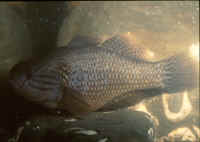
|
| Hypseleotris compressa (Krefft 1864), the
Empire Gudgeon. Australia and South-central New Guinea. To four
inches in length. In the wild feeds on larval insects, small
crustaceans. Shown: one inch aquarium specimen. |
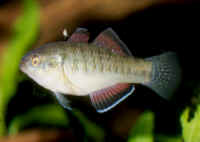
|
| Oxyeleotris lineolatus (Steindachner
1867), the Sleepy Cod. Oceania; Australia and central-south New
Guinea. To sixteen inches in length. Temp. 20-28 C. Eats insects,
crustaceans, fishes in the wild... most everything, everyone in
captivity. |
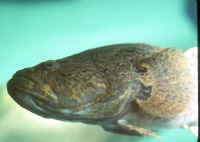
|
Family Gobiidae; Gobies. Mostly
marine, but some fresh, brackish species. Four families, of about 212
genera, 1900 and counting species.
| Awaous flavus (Valenciennes 1837), FW to
brackish. S. American. To 8.2 cm. Photo by Neale Monks.
http://fishbase.org/Summary/speciesSummary.php?ID=47844&genusname=Awaous&speciesname=flavus |
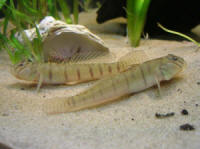
|
| Rhinogobius nagoyae formosanus Oshima 1919,
FW, amphidromous. Asia; ROC and China. To 4.9 cm. Photo by Neale
Monks. |
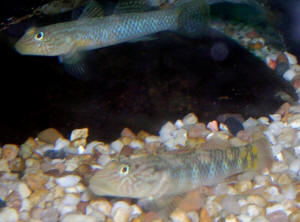
|
| From Neale: "Stiphodon sp. "Gold
Spot". Small, algae/aufwuchs-eating freshwater gobies with a
marine larval stages. Rheophillic, and short-lived if kept in warm,
stagnant conditions. In aquaria they can be difficult to feed, and
need green algae plus suitable small invertebrates." |
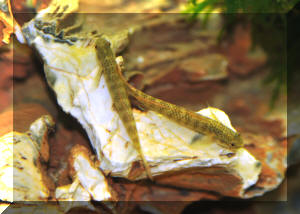
|
Bigger PIX:
The images in this table are linked to
large (desktop size) copies. Click on "framed" images to
go to the larger size. |
|
%20MD.JPG)
|
Subfamily Amblyopinae; worldwide assemblage of gobiid fishes
found off estuaries and in rivers. For aquarists, includes the
"Violet Goby", aka "Dragon Eel", Gobiodies
broussoneneti.
| Gobioides broussonenti Lacepede 1800, the
Dragon Eel/Goby, Violet Goby (3). Western Atlantic, Carolinas to
Brazil, Gulf of Mexico. To twenty inches in length (largest
Caribbean Goby). A difficult fish to keep due to its feeding
strategy of filtering planktonic organisms. |
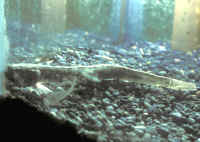
|
Subfamily Ocudercinae;
Mudskippers. Live in Mangrove swamps, mudflats from Africa east to
Samoa. Ten genera (e.g. Apocryptes, Boleophthalmus, Brachamblyopus,
Gobioides, Taeniodes, Trypacuchen), about 34 species.
Subfamily Gobionellinae. 56 genera, many freshwater species.
Including amongst the most popular brackish aquarium species, the tiny,
gentle Bumblebee Gobies (nine species) of the Genera
Brachygobius and Hypogymnobius. A few species are
offered as "the" Bumble Bee Goby: B. nunus, amongst the
others below.
| Brachygobius doriae, (Gunther 1868), Bumble
Bee Goby. Southeast Asia; Sarawak and Kapuas, Western Borneo. To
one and an eighth inches in length. Water Cond.s: temp. 22-29 C. pH
8-8.2, dH 9-19. |
|
| Hypogymnogobius (Brachygobius)
xanthozona (Bleeker 1849), Bumble Bee Fish/Goby. Asia; Java,
Sumatra, Borneo distribution. To one and a quarter inch in length.
Tropical 25-30 C. Folks have a hard time keeping members of this
delightful genus on three counts: Too cold water, not regularly
feeding them live foods, and not providing at least a teaspoon of
salt per ten gallons of their water. |
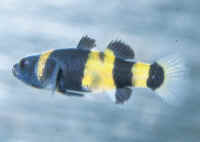
|
|
Excerpted
from: Five Almost Perfect
Fishes; Great fish for the community aquarium, except for
one little thing'¦ by Neale
Monks
5
Bumblebee gobies, Brachygobius spp.
The
good:
A colourful character that does great in hard, alkaline
water
The
bad:
Live or frozen foods -- it won't eat flake!
These delightful little gobies are among
the nicest fish in the hobby. Good specimens have bright yellow
bands set against a black background, and really grab your
attention despite their size. They aren't all that active,
but they are territorial, so while they don't need a huge
amount of space you do need to make sure each fish has its own
territory. The easiest way to do this is make sure there are
plenty of shells or caves in the tank, and the gobies will do the
rest. It's quite good fun to watch these fish go about their
business: they might seem a bit sleepy, but they defend their
homes with remarkable courage! They tend to ignore other fish,
and for the most part other fish ignore them; some people have
even suggested that their black-and-yellow colours are a warning
that they taste bad or are poisonous. Even so, it wouldn't be
wise to rely on this to keep them safe from substantially larger
predatory fish.
Anyway, with bumblebee gobies what you
get is a peaceful, strikingly coloured little fish that will work
nicely in any aquarium with hard water (and preferably a bit of
salt added). Whether or not they are strictly speaking brackish
water fish is a debateable point. All three of the species
commonly sold in tropical fish stores are know to live and breed
in completely fresh water, and there is variation within each
species, with populations found in estuaries needing salt and the
ones found further upstream doing fine in fresh water. Some
populations inhabit soft, acidic waters like those favoured by
many other Asian freshwater fish, while others can be adapted to
live and breed in full-strength seawater! However, most of the
bumblebee gobies traded commercially seem to do best in hard,
alkaline water with a little salt added.
Incidentally, the species sold are
Brachygobius doriae, Brachygobius nunus, and
Brachygobius sabanus. They are collected indiscriminately,
so there's no reason to assume a single batch of fish
contains just one species. Identifying the gobies you have to
species level is extremely difficult; and for the aquarist it is
probably pointless since all three require the same water
conditions. Goby experts consider the only sure-fire way to name
a bumblebee goby is to examine a dead specimen under a microscope
-- something few aquarists are going to want to do. Moreover,
almost all photographs published in books and on web sites are
incorrectly named, so they aren't much help either. About the
only certainty is that one species you won't have is
Brachygobius xanthozona -- although the name is widely
used in the hobby, this goby is so rare that most museums
don't even have specimens of it, let alone tropical fish
stores!
Not that what your bumblebee gobies are
actually called matters all that much, as the they all have much
the same requirements as far as water conditions and feeding go.
Which brings us to the prime flaw of these fine little fishes:
they won't eat flake. Aquarists like their fish to eat flake
and pellet food; for one thing it's inexpensive and
convenient, but more importantly in the long run, good quality
flake food is carefully prepared to ensure your fish get all the
nutrition they need. However, bumblebee gobies just won't eat
flake. They might have a bite, but they'll spit it out, and
you'll definitely need to make other plans as far as feeding
goes. Frozen foods such as bloodworms, lobster eggs, and mosquito
larvae are probably the easiest option to take, though live foods
are perhaps best. Even assuming your gobies will eat what
you're offering, you need to make sure they get a chance to
feed. In many community tanks the other fish will eat up all the
food before the gobies get a mouthful, so if you want to mix
bumblebees with other kinds of fish, choose fish that eat more
slowly or ones that don't take food from the substrate (like
halfbeaks).
|
Family Rhyacichthyidae, the Loach Gobies. Freshwater streams
of the Indo-Australian Archipelago, Philippines, China, the Solomons.
Have depressed heads, compressed tails, underslung mouths that sport a
fleshy upper lip; small eyes, widely separated pelvic fins. Use these
traits to cope with fast-movng water, fins, body shape, mouth to hold
onto hard surfaces... To nearly thirteen inches in length. One genus,
Rhyacichthys, with two species.
There are other families containing freshwater, brackish
gobioids.
Bibliography/Further Reading:
http://www.geocities.com/rubentolon/index.html
Brown, Stanley. 1996. Gobies. V.4, #1 96 The J. of Maquaculture, The
Breeder's Registry.
Hunziker, Raymond E. 1985. Gobies for freshwater and brackish
aquaria. TFH 12/85.
Nelson, Joseph S. 1994. fishes of the World, 3rd ed. John Wiley
& Sons, NY. For systematic reviews.
Gobies:
Castro, Alfred D. 98. Knight Goby. How to keep 'em and how to
breed 'em. AFM 6/98.
Kurtz, Jeff. 2000. The Knight Goby. A good reason to go brackish.
TFH 11/00.
Schofield, Diane. 1965. Busy little bees. TFH 1/65
Tomey, William A. 1969. The Grey Pearl of Siam. The Aquarium.
8/69.
Sleepers
Anon. 1982. A Peacock out of paradise. Aquariums Australia 2:3,
82.
Lange, Gary. 2000. Modern masterpiece- The Peacock Gudgeon. A tiny
work of art. AFM 6/00.
Rosler, Hans Jurgen. 1997. The care and breeding of Tateurndina
ocellicauda. TFH 2/97.
Schreiber, Roland. 1995. The Fiery Sleeper. TFH 9/95.
Tappin, Adrian R. 1998. The Empire Gudgeon. FAMA 1/98.
Walker, Braz. 1970. The Spotted Sleeper. The Aquarium 4/70.
Loach Gobies:
Dingerkus, Guido and Bernard Seret. 1992. Rhyacichthys
guilberti, a new species of Loach Goby from Northeastern New
Caledonia (Teleostei: Thyacichthyidae). TFH 7/92.
Mudskippers:
Hansen, Pamela and Jorgen. 1979. The Mudskipper. TFH 7/79.
Lass, David. 2001. Mudskippers. A fish becoming an amphibian. AFM
2/2001.
Lucanus, Oliver. 1998. A fish out of water- Mudskippers. TFH
3/98.
Mancini, Alessandro. 1991. Mudskippers in nature and captivity. TFH
6/91.
McGregor, Glenn. 1999. Mudskippers: like a fish out of water. FAMA
4/99.
Murdy, Edward O. 1986. Mudskippers of Malaysia. The lords of the
mudflat.FAMA 11/86.
Norris, T.L. 1984. A community Mudskipper tank. FAMA 9/84.
Ono, Dana R. and Debra Sponder. 1982. Table-top Mudskippers. FAMA
10/82.
Schwartz, Gerd. 1975. The Mudskipper. Aquarium Digest Intl. 3:4,
75.
Sidley, Rodney. 1984. Keeping Mudskippers. FAMA 12/84.
Taylor, Edward C. 1997. Mudskipper environment. Pet Business
11/97.
Volkart, Bill. 1996. Mudskippers: Demanding by rewarding. TFH
5/96.
Violet Goby, Dragon Eel:
Boruchowitz, David. 2001. A sickly dragon. TFH 2/01.
Harper, Rodney W. 1995. Captive care and maintenance of the Violet
Goby, Gobiodies broussoneneti. TFH 7/95.

